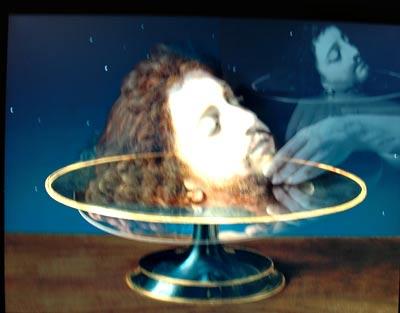A Gaga Transformation

Lady Gaga is a musical artist with a strong visual sense who transforms herself regularly from public appearance to public appearance, record to record, video to video. Robert Wilson works with performers, composers, and writers to create highly visual, mostly musical productions.
While much was made of Gaga’s collaboration with Jeff Koons on the art work for her “Art Pop” album and the related art pieces, launch parties, and joint appearances, a more satisfying union has occurred with Mr. Wilson, the results of which are on view now at the Watermill Center.
Mr. Wilson employed his signature medium of video portraits in this alliance, working on them with the performer in London in the weeks before his show “Living Rooms” opened at the Louvre in December. The subjects in this series were taken from art in the Louvre or have strong French cultural resonance, such as Jacques-Louis David’s “Death of Marat,” the French revolutionary who was killed in his bath by Charlotte Corday.
There was a 1963 Peter Weiss play about the Marquis de Sade directing a play about Marat in an insane asylum where he was an inmate. The association with modern drama, and even a Brechtian-style musical score, may have had further resonance for Mr. Wilson’s, and the pop singer’s, own flair for the dramatic.
Lady Gaga takes up the guise of Marat, and it’s a worthy interpretation of the neoclassical David image ingrained in anyone with a hint of cultural literacy. To happen upon it just for a minute or so, it would appear the image is static, but as time passes little tics and blinks and tears appear in each of the portraits on view with more surprises worth the wait.
The other images the artist appropriates in stunning detail include Jean-Auguste-Dominique Ingres’s “Portrait of Mademoiselle Caroline Riviere‚” from 1806 and Andrea Solari’s “Head of Saint John the Baptist” from 1507. Both of these paintings are in the Louvre. And all of them, even the Ingres portrait of the teenaged girl, are about death (the subject having died not long after it was painted).
The evocation of themes of still life, specifically memento mori and vanitas, carry over into these modern recreations. Rebels like St. John the Baptist and Marat lived dangerously and perhaps courted death, but even the young and innocent are not immune to its fickle nature. In today’s culture, is there anything that evokes vanity more than pop celebrity? Lady Gaga, with her own cultish following, is a suitable icon for this kind of treatment, and her chameleon-like transformations into these subjects is striking.
“Flying,” an unrelated image of the artist upside-down, naked, and bound in the form of Japanese shibari, is fascinating as well in this context. Throughout the exhibition Mr. Wilson merges classical imagery and its timeless themes with traditional theatrical techniques and modern high-definition technology. Here the motion is more explicit and the presentation black-and-white and lo-fi. In this context, however, the binding loses its inherent titillating properties and adopts a more meditative tone, becoming a reflection on the human spirit bound on earth, a medieval Western theme with parallels to the Tibetan Book of the Dead.
Except for the Solari work, the images are presented on single large-format high-definition screens at opposite ends of the gallery. On the walls in between, details of John’s head in the silver salver are done serially. Instead of recreating the scene entirely, in these works Lady Gaga’s features are super-imposed on the actual painting. This gives the series an eerie, animated quality, bringing to mind the rigor mortis of severed heads and the classic horror-film trope of the portrait with moving eyes.
The works are on view through Sept. 14.
